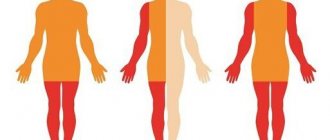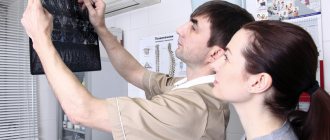When a person feels numbness in their legs
, this means that the sensitive part of the peripheral nerve is affected. Not only sensitivity is lost, but also burning and tingling, tightness, “cottoniness”, goosebumps, coldness, sometimes the accuracy of movements is impaired and a feeling of uncertainty when walking and dizziness occurs. The nerves of the lower limb are numerous, begin in the spinal cord, and branch along their course into many branches. The legs receive nerve impulses through both large (femoral, sciatic, tibial) and small nerves. The central analyzer of sensitivity is the structures of the brain.
The nerves of the lower limb can directly receive mechanical damage (for example, bony outgrowths of the vertebrae, so-called osteophytes, “ossified” ligaments, herniated intervertebral disc), and also be damaged as a result of the inflammatory process or metabolic (metabolic) disorders. CELT doctors, who have modern diagnostic equipment at their disposal, will help you find the cause.
At CELT you can get advice from a neurologist.
- Initial consultation – 3,500
- Repeated consultation – 2,300
Make an appointment
Do you always need to see a doctor?
There is no need to worry only if there is numbness
left or
right leg
occurs once after an uncomfortable position (what is popularly called “served time”). Soon after the physiologically normal posture is restored, the numbness should also disappear. Other harmless reasons include:
- Hypothermia - the human body reacts to cold starting from the lower extremities, so it is best to keep them warm;
- Wearing ill-fitting shoes that are too tight or narrow can lead to numbness in your toes
; - Bearing a fetus - a symptom occurs due to an increase in the volume of fluid in a woman’s body;
- A sedentary lifestyle and frequent sitting leads to numbness in the feet
and legs below the knee.
In all other cases, especially when numbness recurs regularly, it is imperative to look for the cause. Most likely, some pathological process is occurring in the body, and given the extreme “fragility” of nerve fibers and the complexity of their regeneration, delaying diagnosis can lead to irreversible consequences. The following points should be of particular concern:
- there is no obvious reason for the numbness, but it often recurs;
- problems with coordination arise, the leg “clings” or “stammers”;
- walking becomes difficult;
- difficult or impossible to distinguish between warm and cold;
- worries about weakness or dizziness;
- urination is impaired.
These symptoms may indicate a circulatory disorder in the nervous system, that is, they may be signs of a stroke. Or they may indicate acute damage to the nervous system of some other etiology. With such disorders, the timing of medical care is important. For example, if it is possible to restore blood flow in the brain during the first three hours, then there may be no consequences in the form of paresis or paralysis or speech impairment. Modern medical technologies used in CELT make it possible to help those who had no chance yesterday.
Features of the pathology
Paresthesia of the lower extremities occurs most often in older people.
The fact is that this pathology is manifested by a violation of nervous activity as a result of an uncomfortable body position.
The nerve is compressed and released only after the person changes body position.
After changing the position, a fairly rapid restoration of nervous activity occurs.
The elasticity of nerve tissue decreases significantly as a result of pathological age-related changes. They are most often caused by diseases of the cardiovascular system.
Sometimes paresthesia of the lower extremities can occur for other reasons. They can be factors of a psychogenic nature or intoxication of the body.
It should be noted that disorders of nervous activity that are temporary in nature may occur for reasons that are not associated with pathological changes.
Thus, temporary paresthesia occurs during dental treatment using local anesthesia, when, as a result of the effects of the drug, patients feel numbness of the lips, part of the tongue or chin.
Etiology
Most common causes of numbness in the legs
consist in the presence of pathological processes in the spine - however, this is not all. The etiology of this symptom may be as follows:
- arthritis;
- pathological conditions of a systemic nature;
- multiple sclerosis;
- blood flow disturbances.
The area in which the feeling of numbness is localized will help to more accurately determine the cause.
| Numb area | Diseases characterized by this symptom |
| Hips/thigh |
|
| Above the knees |
|
| Calves of the legs |
|
| Below the knees |
|
| Foot/feet |
|
| Numbness in left leg |
|
| Numbness in right leg |
|
Paresthesia: what is it?
This term refers to a sensitivity disorder in which a person feels a burning, tingling or “crawling” sensation. These are subjective sensations associated with objective reasons. As a rule, they are associated with irritation of a nerve that lies close to the surface of the skin. This may be the result of a shock, mechanical pressure, or due to a temporary interruption of the blood supply.
The main factors leading to paresthesia:
- prolonged compression, for example, of a limb;
- osteochondrosis of any part of the spine;
- tumors of different nature (benign, oncological);
- tourniquets that are applied to stop bleeding;
- nerve ending injuries;
- burns, exposure to high temperature (this may cause problems with the sensitivity of the tongue and lips);
- inflammation in the vascular tissues that supply nerve cells with blood;
- diabetes mellitus and other hormonal disorders;
- poisoning with chemical poisons, biological toxic substances;
- deficiency of certain B vitamins;
- Iron-deficiency anemia;
- intermittent claudication;
- atherosclerosis;
- incorrect position at night (during sleep);
- mechanical shocks.
Clinical manifestations
In pathological conditions, numbness of the legs is a symptom that is always accompanied by a number of others. Depending on the etiology, they may be different, but the general picture is approximately as follows:
- Feeling of heaviness in the lower extremities;
- Gait disturbances;
- Inability to distinguish cold from hot;
- Fatigue, constant weakness and weakness;
- Tingling and goosebumps;
- Cramps and increased pain at night;
- Sudden and sharp appearance of pain in the chest and spine;
- Itching and burning of the skin, sometimes blueness;
- Severe headaches and dizziness.
Accompanying illnesses
Paresthesia often develops against the background of such pathologies:
- sciatica;
- cervical spondylosis;
- diabetic neuropathy;
- transverse myelitis;
- restless legs syndrome (tingling and burning in the legs).
If complications occur, the disease can progress rapidly. Therefore, patients with these diseases should undergo periodic medical examination.
Diagnostics
The use of modern instrumental diagnostic methods makes it possible to establish the cause quickly enough. Doctors have the following methods in their arsenal:
- radiography - reveals bone deformations, calcifications and other dense formations;
- - allows you to examine the bones and substance of the brain and spinal cord, and other soft tissues;
- MRI - detects defects in almost all structures, the vascular mode gives an objective picture of blood flow;
- electroneuromyography (ENMG of the lower extremities) - reveals defects in neuromuscular transmission;
- Ultrasound or sonography detects cysts, tumors and other formations, allows you to evaluate the structure of blood vessels;
- general clinical and biochemical blood tests.
CELT doctors have accumulated vast clinical experience, daily comparing data on various diseases. Specialists will be able to find out the exact cause of suffering and suggest the most effective method of treatment so that everything ends in recovery.
Rehabilitation and recovery measures
In most cases, the combination of drug treatment with manual therapy and spinal traction allows for a quick resolution of the acute period of the consequences of osteochondrosis, but to fully restore function and prevent relapse, it is necessary to undergo a course of rehabilitation measures: physical therapy, physiotherapy and acupuncture, massage.
All this will require time and effort; neurologist specialists at the international clinic Medica24 always take into account not only the individual characteristics of the disease, but the capabilities and interests of each patient, so that the treatment is as comfortable as possible and improves the quality of life.
Our doctors
Novikova Larisa Vaganovna
Neuropathologist, Candidate of Medical Sciences, doctor of the highest category
Experience 39 years
Make an appointment
Pankov Alexander Rostislavovich
Neurologist
40 years of experience
Make an appointment
Treatment
Any numbness that occurs several times over a short period of time—a week or a month—requires consultation with a doctor. The sooner the cause is identified, the greater the chances of a positive outcome. You need to understand that a nerve is a dynamic formation that has its own extremely complex physiology. For severe damage to nerve tissue, intense exposure to any pathogenic factor for just a few minutes may be enough, and nerve regeneration takes months. The nerve can be kept healthy or fully restored only if measures are taken in time.
Treatment of numbness in the legs
, first of all, is aimed at eliminating the cause that caused this symptom. Its selection is carried out individually, based on diagnostic data, situation and indications of the patient. The treatment itself is carried out in a complex and may include the following:
| Techniques | Features of application |
| Drug therapy |
|
| Manual therapy | Therapeutic techniques aimed at eliminating blocks in joints and muscles that lead to compression of nerve roots and blood vessels, as well as stimulating blood flow in the affected area. |
| Physiotherapeutic procedures | Using techniques aimed at stimulating blood flow in the affected area:
|
| Exercise therapy | Performing a set of individually selected exercises under the supervision of an instructor will help strengthen the muscle corset around the spine, stimulate tissue trophism and blood flow. |
Main symptoms
The main symptoms of the disease, regardless of the type, include:
- numbness – weak and strong;
- tingling;
- burning sensation;
- the feeling that goosebumps are crawling all over the body.
Indirect signs are:
- pale skin;
- previously unexperienced hair loss;
- decrease in temperature (only in the affected area).
Often these symptoms occur in the feet, in the neck, especially on the side, on the hands, and in the head area. Normally, such sensations gradually disappear without treatment. But if they are repeated again and again and become pronounced and long-lasting, this clearly indicates the development of the disease. In such cases, you need to consult a doctor for diagnosis and treatment.
Prevention
In order to eliminate such a manifestation as numbness of the legs, you must adhere to simple rules, which are as follows:
- Rejection of bad habits;
- Reducing salt intake;
- Active lifestyle;
- Proper, balanced nutrition;
- Providing the body with all the microelements and vitamins it needs;
- Avoiding high-heeled shoes or keeping them to a minimum;
- Sports activities;
- Attention to your health;
- Timely seeking professional help if certain symptoms occur.
MC CELT specialists give a positive prognosis for timely treatment of numbness in the legs. Trust your health to professionals!
Make an appointment through the application or by calling +7 +7 We work every day:
- Monday—Friday: 8.00—20.00
- Saturday: 8.00–18.00
- Sunday is a day off
The nearest metro and MCC stations to the clinic:
- Highway of Enthusiasts or Perovo
- Partisan
- Enthusiast Highway
Driving directions
Why you shouldn't ignore leg numbness
Ignoring the symptom and neglecting to visit a doctor can lead to adverse consequences and progression of the pathology underlying the numbness.
Failure to seek medical help in a timely manner can lead to the following consequences:
- complete and permanent loss of sensation;
- loss of motor function (paresis, paralysis);
- intervertebral hernia, sequestration of hernia;
- dysfunction of the pelvic organs;
- amyotrophy;
- atrophic ulcers;
- leg deformity;
- gangrene.
The outcome can be very depressing, so you should not delay visiting your doctor.










